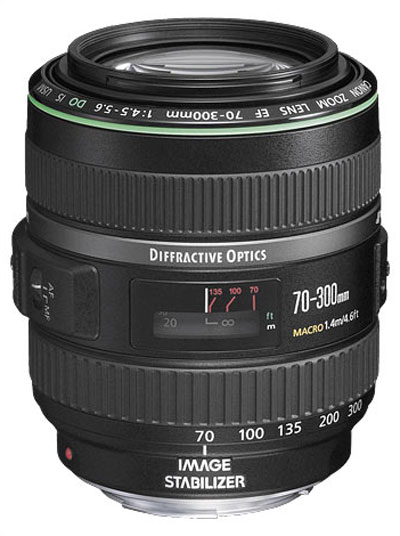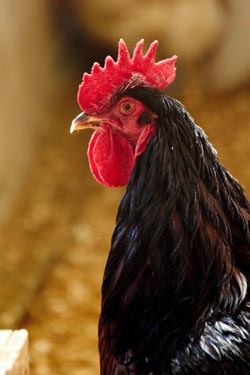Canon EF 70-300mm f/4.5-5.6 DO IS USM
On paper, the specification of this lens doesn't really seem all that special, but what makes this lens interesting is the Diffractive Optics (DO) technology employed in the design. An in-depth description of the technology can be found on Canon's USA website here:
Canon EF 70-300mm f/4.5-5.6 DO IS USM Diffractive Optics explained
Simply put, a DO element comprises of two glass elements, which are etched on their facing surfaces with concentric lens surfaces, in a similar way to that found on a fresnel lens but with a few important alterations. The width of the concentric surfaces gets narrower towards the edges of the lens, which gives the elements aspheric properties, and promises to help control colour aberrations more effectively. It also allows for more compact lens designs. This lens is only 100mm long, which is tiny for the focal range it covers. Being the only lens of it's kind currently available, it is priced at a premium, costing around £1199. Canon currently offer a few other lenses that cover this range. The EF 75-300mm IS USM lens, is under half the price at roughly £430 and their basic non-image stabilised 75-300mm is priced at only £237.
No other manufacturer currently offers a lens with this technology, but in the interest of comparison, Tamron's 70-300mm Macro costs only £132 and Sigma's 70-300mm with Optical Stabilisation costs around £300.
Canon EF 70-300mm f/4.5-5.6 DO IS USM: Handling and features
A prominent green stripe around the front of the lens lets everyone know your using a DO lens and not any common Canon lens. Keeping with the theme of separating this lens from the lower priced equivalents, the build quality is superb. Although it is compact, it is not light for this kind of lens, weighing 720g, mostly due to the high quality materials employed in the lens' construction.
Zooming is performed with little resistance from the lens' internal mechanisms, which is great for quick composition, but not so great if you wish to point the lens downwards, as zoom creep is an issue with the sample supplied for testing. When the lens is pointed downwards is instantly slides out to just beyond 135mm.
Focusing is fast and accurate, thanks to the Ultrasonic focus motor. Manual focus adjustments can be made at any time, just grab and turn the focus ring to make an adjustment. Due to the great build quality and compact size, I really enjoyed using this lens.
Canon EF 70-300mm f/4.5-5.6 DO IS USM: Performance
For this review, the lens was tested on a 15.1Mp Canon EOS 500D using Imatest.
During testing, this lens was very well behaved. The sharpness across the frame is pretty much uniform, which is very impressive, especially for a zoom lens of this range.
At 70mm, the resolution is excellent at f/4.5 across the frame, and the performance seems to deteriorate as the lens is stopped down. As zoom lenses of this kind will be shot at wide apertures much of the time, I do not see this as a problem. With the lens zoomed into 135mm, the resolution remains impressive at most apertures, with peak performance being at f/8. Finally, at 300mm, there is a drop in resolution on the tested sample, but the results are still acceptable at f/5.6, and good at f/8. Strangely, this lens performed best at f/22 at 300mm, which is a setting I would imagine this lens would rarely see in normal use.
| Resolution at 70mm |
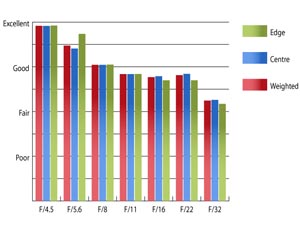 |
| Resolution at 135mm |
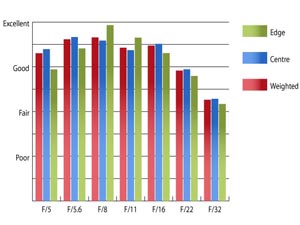 |
| Resolution at 300mm |
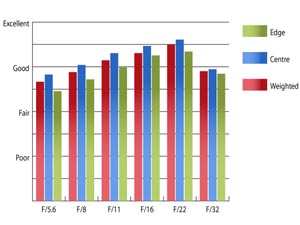 |
It looks as though the Diffractive Optics do as Canon say they do, as there are no issues with colour fringing to speak of here. At their worst, they just exceed three quarters of a pixel-width, which will not be visible in most picture taking scenarios.
| Chromatic Aberrations at 70mm |
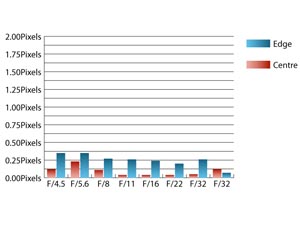 |
| Chromatic Aberrations at 135mm |
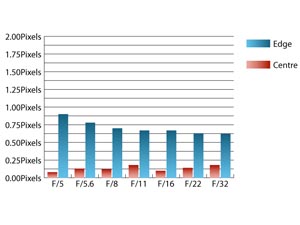 |
| Chromatic Aberrations at 300mm |
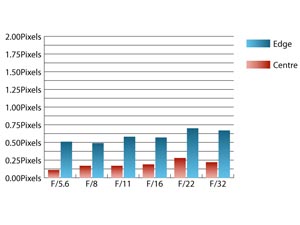 |
Vignetting is fairly well controlled, with corners only being 1stop darker than the image centre at f/4.5 and 70mm. This amount of vignetting is fairly constant throughout the zoom range, with the corners being 1.3stops darker than the image centre at 300mm.
Distortion is well controlled for a lens of this range. At 70mm Imatest recorded only 0.45% barrel distortion and at 300mm only 0.9% pincushion is present.
Flare and ghosting is reasonably well controlled. Strong point sources of light barely flare at all, there is quite a severe loss of contrast in these kinds of situations though, possibly due to the diffractive elements.
The Image Stabiliser fitted to this lens isn't one of the newer type, but is still perform well enough to be a very useful feature. Hand-holding at 300mm, I was able to get sharp shots at 1/15sec most of the time.
 | DxOMark provides objective, independent, RAW-based image quality performance data for lenses and digital cameras to help you select the best equipment to meet your photographic needs. Visit the DxOMark website for tests performed on the Canon EF 70-300mm f/4.5-5.6 DO IS USM. |
Canon EF 70-300mm f/4.5-5.6 DO IS USM: Verdict
If money were no object and you wanted a compact telephoto zoom lens with an image stabiliser that produces sharp images at all focal lengths, then this would be the lens for you.
Unfortunately, most of us do have to consider the price at some point. This lens costs more than double what the standard EF 75-300mm IS USM does. Although the cheaper lens may be physically larger, it actually only weighs 650g, which is 70g less. This alone makes me question whether the £1199 price tag could ever represent good value.
| Canon EF 70-300mm f/4.5-5.6 DO IS USM: Pros |
 Good resolution Good resolution |
 Excellent build quality Excellent build quality |
 Compact size Compact size |
 Low distortion Low distortion |
| Canon EF 70-300mm f/4.5-5.6 DO IS USM: Cons |
 Price Price |
 Zoom creep Zoom creep |
 Less contrast when shooting into the light Less contrast when shooting into the light |
| FEATURES |  |
| HANDLING |  |
| PERFORMANCE |  |
| VALUE |  |
| OVERALL |  |
Canon EF 70-300mm f/4.5-5.6 DO IS USM: Specification
| Price | £1199.99 |
| Contact | www.canon.co.uk |
| Filter size | 58mm |
| Format | Full frame |
| Construction | 18 elements in 12 groups |
| Angle of view | 34° - 8° 15' |
| 35mm equivalent focal length (on APS-C body) | 112 - 480mm |
| Internal focusing | Yes |
| Image stabilisation | Yes |
| Minimum focus | 140cm |
| Maximum aperture | f/4.5 - 5.6 |
| Minimum aperture | f/32 - 46 |
| Weight | 720g |
| Size | 100x82.4mm |
| In the box | Lens caps |
The Canon EF 70-300mm f/4.5-5.6 DO IS USM costs around £1199.99 and is available from Park Cameras here:
Canon EF 70-300mm f/4.5-5.6 DO IS USM
Add your message
Login required
Please login here or if you've not registered, you can register here. Registering is safe, quick and free.
Please login here or if you've not registered, you can register here. Registering is safe, quick and free.
photodo Stats
1102 lenses
428 MTF tests
74 in-depth photodo reviews
100+ users join each day
Help the lens community by reviewing or rating a lens today via our lens search
428 MTF tests
74 in-depth photodo reviews
100+ users join each day
Help the lens community by reviewing or rating a lens today via our lens search
Latest Lens Reviews
- Chinon 28mm f/2.8 Vintage Lens Review
- Canon EF 70-200mm f/4L IS II USM Lens Review
- Samyang AF 85mm f/1.4 EF Review
- Sigma 70mm f/2.8 DG Macro Art Review
- Samyang AF 24mm f/2.8 FE Review
- Meike 50mm f/1.7 Review
- Tamron 70-210mm f/4 Di VC USD Review
- Lensbaby Burnside 35mm f/2.8 Review
- Asahi Super Takumar 50mm f/1.4 Review
- Asahi Super-Multi-Coated Takumar 135mm f/3.5 Review
